Examining the Variation in Guitar Styles and Different types of strumming instruments
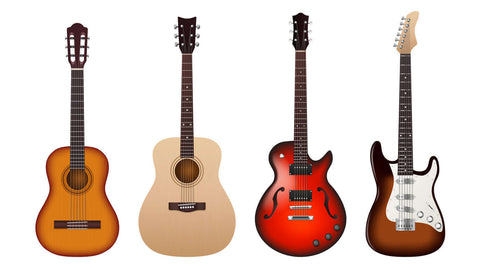
Guitars are beloved by both artists and music aficionados and are among the most recognizable and adaptable musical instruments. As one of the most popular types of strumming instruments, there are several different kinds of guitars, each with their own distinct qualities and appeal, ranging from the gentle melodies of acoustic guitars to the thrilling chords of electric guitars. This article delves into the intriguing realm of guitars, examining their diverse varieties, attributes, and appropriateness for distinct playing styles and genres.
1. Acoustic guitar
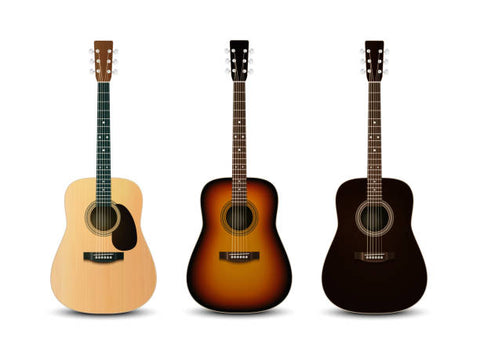
That thing known as an acoustic guitar, you know? It is essentially this amazing musical instrument that produces sound by allowing the vibrations of its strings to be absorbed by the wood body. Imagine this: a long neck with several lines drawn on it, and a wooden box with a hole in the middle. When you apply pressure to those lines, you'll hear distinct noises emerge.
People utilize it for a wide variety of songs, including rock, country, and folk. Whether you're plucking or strumming, it seems like you have your very own musical friend that is always willing to jam with you. As one of the most popular types of strumming instruments, acoustic guitars are well known for their classic style and cozy, organic tone. They are available in various variants, each designed to accommodate various musical genres and playing techniques.
2. Acoustic Steel-string Guitar
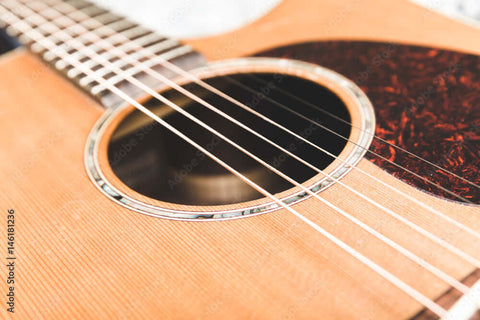
Now, you are aware of acoustic guitars, correct? Imagine one, though, with steel strings rather than those more delicate ones. We refer to that as an acoustic steel-string guitar. It sounds bright and punchy, making it ideal for a wide range of musical genres, including blues, folk, country, and more. It's excellent for strumming and plucking out melodies because of the steel strings, which also give it some more power and longevity. Like the workhorse of the guitar world, it's always ready to rock.
The most popular kind of acoustic guitars are probably steel-string models, which are renowned for their bright, clear sound and adaptability. They provide a rich tonal palette and superb projection, which makes them popular in pop, country, and folk music. The Martin D-28, Taylor 814ce, and Gibson J-45 are well-known models.
3. Classical Guitar
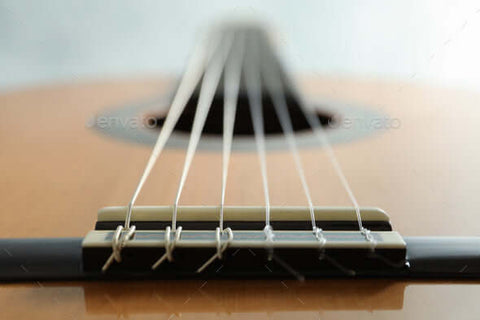
Okay, let me to explain it to you. The original guitar is comparable to a classical guitar. It's the one where the strings are made of soft nylon rather than the metal ones you may be accustomed to. Compared to other guitars, you'll note that it's a little bit smaller and has a wider neck. It is primarily used in classical music, while it is also present in Latin and flamenco songs. It just envelops you with its soft, comforting sound. Furthermore, to pluck out those lovely melodies, classical guitarists frequently use their fingers rather than a pick when strumming.
Nylon-string guitars, commonly referred to as classical guitars, have a mellower, gentler sound that makes them perfect for fingerstyle, flamenco, and classical music. They make fingerpicking techniques more comfortable to play because of their bigger necks and lower string tension. Among the well-known classical guitars are the Yamaha C40, Cordoba C5, and Ramirez 1A.
4. Flamenco Guitar
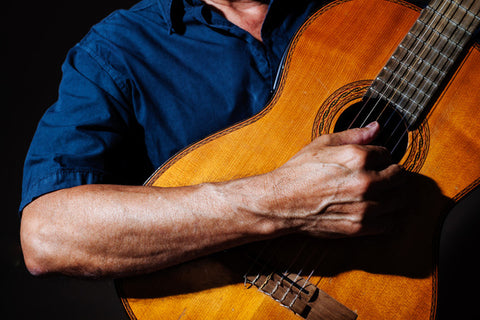
Okay, so let's discuss flamenco guitars. These babies resemble the fiery spirit of Spanish flamenco music. Imagine a guitar with an extra dose of attitude. As one of the most unique types of strumming instruments, flamenco guitars are made to be powerful, yet they still feature those nylon strings like their classical counterparts. Their vibrant, percussion-heavy sound is ideal for the intense rhythms and melodies of flamenco. To manage all that strong strumming, you'll often find them with a deeper body and a stylish golpeador (a protective tap plate).
These guitars are the fiery partners in crime for flamenco guitarists, who don't just play the music; they feel it in their bones.
Flamenco guitars are a great fit for flamenco and Spanish music because of its fast response time and percussion-like tone. They frequently have a lower action and shallower body to enable fast strumming and complex fingerstyle patterns. Notable flamenco guitars are the Alhambra 7Fc, Paco de Lucía's bespoke guitars, and the Conde Hermanos AF25.
5. Archtop Guitar
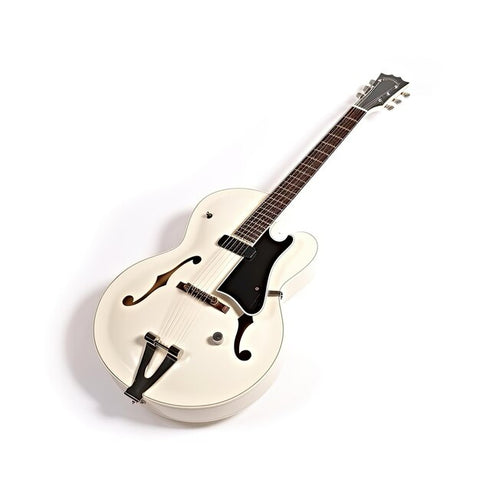
The characteristic curved top and f-shaped sound holes of archtop guitars produce a warm, resonant tone that is popular among jazz and blues performers. They provide a mellow, silky sound that is perfect for soloing and improvisation, along with great sustain. Classic archtop guitars include the Gretsch White Falcon, Gibson L-5, and Epiphone Emperor.
6. Electric Guitar
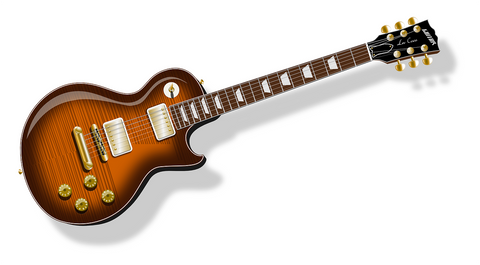
Now, let us explore the realm of electric guitars. These nasty boys resemble the guitar world's rock stars. Electric guitars use pickups to transform string vibrations into electrical impulses rather than depending on the inherent acoustics of a hollow body. They provide the foundation of several genres, including jazz, blues, and rock 'n' roll.
Electric guitars are available in a wide range of sizes and styles, from traditional models like the Stratocaster to more daring ones like the Flying V. Their raw, captivating tone can be sculpted and molded to create countless variations using effects pedals and amplifiers. Modern music would not be the same without electric guitars, whether you're pounding out a solo or laying down some tasty riffs.
Electric guitars' amplified tone and limitless sonic possibilities changed the music industry. They accommodate varied playing techniques and musical genres and are available in a variety of shapes and configurations.
7. Electric Solid-body Guitar
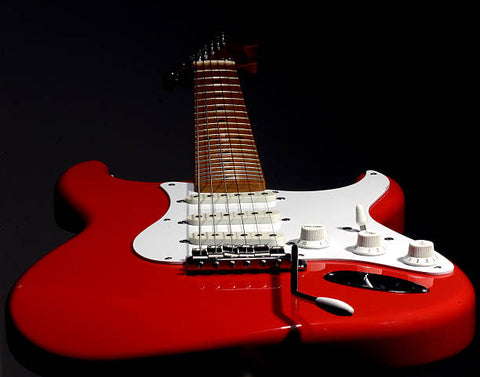
The most popular kind of electric guitars are solid-body models, which are valued for their longevity and adaptability. They have an electromagnetic pickup system with a solid wood body that produces a wide spectrum of tones appropriate for jazz, blues, rock, and other genres. The PRS Custom 24, Gibson Les Paul, and Fender Stratocaster are a few well-known solid-body electric guitar models.
8. Semi hollow Body Guitar

The warmth of acoustic resonance and the feedback resilience of solid-body construction are combined in semi-hollow body guitars. For musicians looking for a vintage-inspired sound, jazz, blues, and indie rock performers prefer them for their rich, nuanced tone. Several well-known guitars with semi-hollow bodies are the Gretsch G5420T, Gibson ES-335, and Epiphone Casino.
9. Hollow Body Guitar
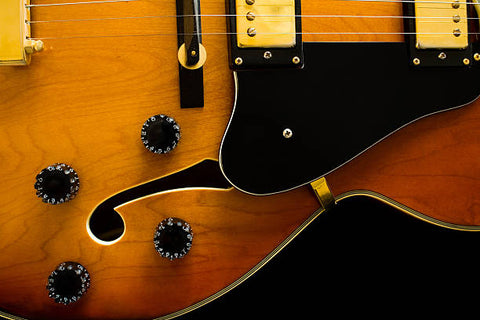
The hollow chamber in hollow body guitars improves its sustain and acoustic resonance. They evoke the timeless tones of the 1950s and 1960s and offer a warm, full-bodied tone perfect for rockabilly, blues, and jazz music. Several well-known hollow body guitars are the D'Angelico EX-DC, Gretsch G6136T, and Gibson ES-175.
10. Bass Guitar

Now, let's discuss bass guitars. These young talents are the hidden heroes of the group, providing the bass-heavy beats that compel you to move. As one of the essential types of strumming instruments, bass guitars are tuned lower to produce those deep, rumbling tones, and they have longer necks and thicker strings than ordinary guitars. Their consistent beat and funky basslines serve as the core of the song, tying everything together. Bass guitars are available in a wide range of sizes and styles, from sleek, contemporary versions to vintage staples like the Precision Bass.
Bass guitars can be used for slapping, popping, or just keeping it simple. They add that special groove that makes people's feet tap.
Bass guitars are essential in defining the beat and groove of contemporary music, serving as the basis for ensembles and bands in a variety of genres.
11. Electric Bass Guitar
The most popular kind of bass guitars are electric ones, which are renowned for their robust low-end response and rich, punchy sound. They accommodate a range of playing techniques and musical genres with their diverse configurations, which include four-string, five-string, and six-string variants. The Rickenbacker 4003, Music Man StingRay, and Fender Precision Bass are three examples of iconic electric bass guitars.
12. Acoustic bass Guitar
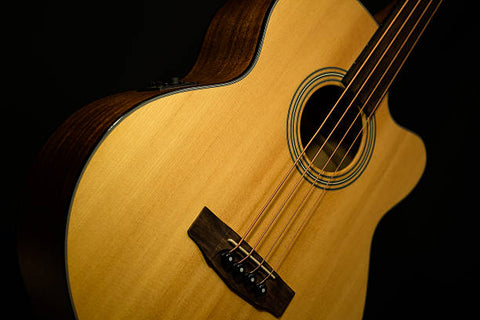
A small performance or acoustic ensemble can benefit from the more natural, unplugged sound that an acoustic bass guitar provides. Folk, jazz, and bluegrass performers frequently use them because of their warm, rich tone and superb projection. Ibanez AEB10E, Guild B-140E, and Taylor GS Mini-e Bass are a few well-known examples of acoustic bass guitars.
Unique Guitar
Apart from the standard acoustic and electric guitars, there are a number of specialized guitars made for certain playing styles and target audiences.
13. Guitars with Resonators
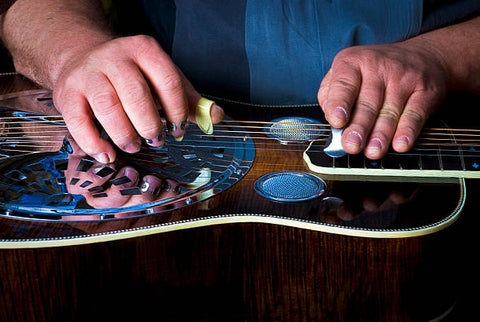
A metal cone or resonator plate that amplifies the sound made by the strings is a feature of resonator guitars. They provide a particular flavor to any musical arrangement and produce a characteristic twangy tone that is perfect for blues, bluegrass, and slide guitar playing. The Regal RC-51, National Style O, and Dobro Hound Dog Deluxe are a few well-known resonator guitars.
14. 12-string Guitar
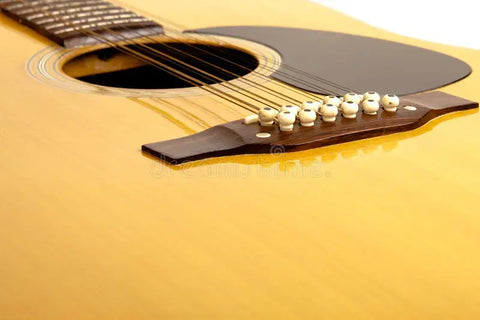
Twelve-string guitars provide a rich, shimmering sound that is evocative of an orchestra in full by doubling each string with a higher octave pair. They are frequently utilized to give chordal passages and arpeggios in folk, rock, and acoustic music more depth and richness. Notable twelve-string guitars consist of the Rickenbacker 360/12, Guild F-512, and Taylor 356ce.
15. Travel Guitar
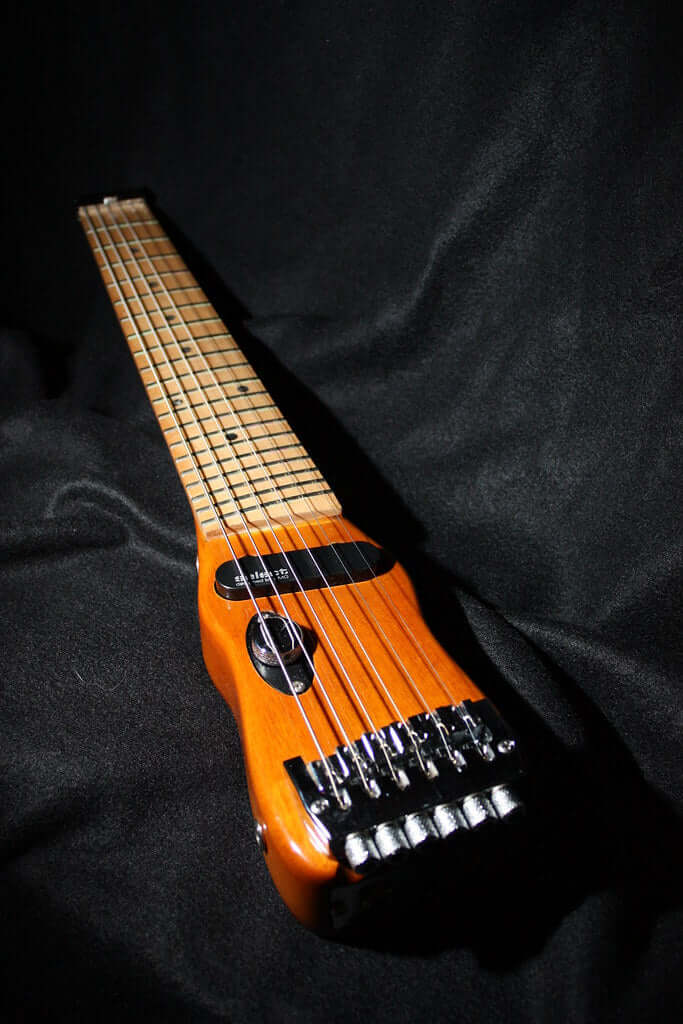
Compact and lightweight, travel guitars are made for artists who are constantly on the go. Their collapsible construction and reduced body size make them perfect for practicing, jamming, or performing whether commuting or on the go. The Yamaha APXT2, Taylor GS Mini, and Martin Backpacker are notable travel guitars.
16. Baritone Guitar
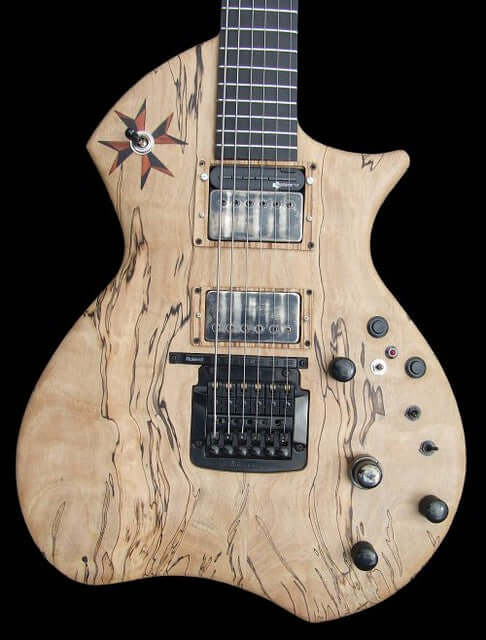
Baritone guitars provide a deeper, more resonant sound because they are tuned lower than regular guitars. They frequently serve as a defining counterpoint to higher-pitched instruments like lead guitars or voices, adding richness and dimension to musical arrangements. The Gretsch G5265, PRS SE 277, and Danelectro Baritone are a few well-known baritone guitars.
Comparing Various Factors while choosing a Guitar
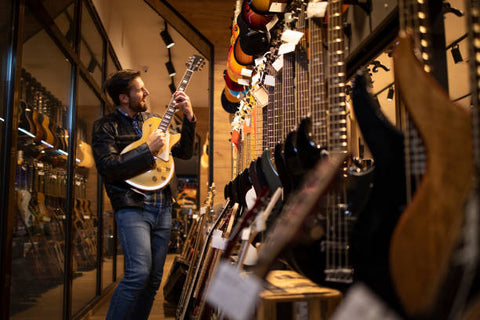
It's important to take into account aspects like playability, sound quality, and genre compatibility while selecting a guitar.
Audio Clarity🎧
Every style of guitar has a distinct sound, ranging from warm and soothing to sharp and percussive. Trying out various guitars will assist you in determining the ideal tone for your playing style and musical tastes.
Versatility and Playability💥
The neck profile, scale length, and string gauge of guitars differ, which has an impact on playability and comfort. While some guitars are great for strumming or soloing, others are better suited for fingerpicking. When choosing a guitar, take your desired playing style and musical objectives into account.
The suitability for Various Genres🎵
Certain musical genres or playing techniques are better suited for particular guitar models. Acoustic guitars are preferred for folk, country, and singer-songwriter music, whereas electric guitars are typically connected with rock, blues, and metal. Select a guitar that reflects your creative vision and goals in music.
Things to Take Into Account While Selecting a Guitar🎸
A number of considerations should be made while buying a guitar in order to guarantee the finest sound quality and playing experience.
There is a large variety of guitars to choose from, ranging in price from high-end professional instruments to entry-level models that are affordable. Given your financial situation and your long-term musical objectives, establish a reasonable budget, bearing in mind that quality is frequently more expensive.
Level of Ability and Playing Style🎸
When choosing a guitar, take your playing style and ability level into account. A simple, easy-to-play guitar might be ideal for beginners, but a more specialized guitar made to match the demands and tastes of advanced players might be necessary.
Consider the tone and appearance you want in a guitar. Warm and quiet sounds or bright and twangy ones are your favorites? Which designs—classic or contemporary—draw you in? take a guitar that motivates you to take it up and play in addition to having amazing tone.
Conclusion
Guitars are more than simply instruments for playing music; they are tools for artistic expression and can evoke a variety of moods and feelings. The kind of guitar you choose can have a significant influence on your playing style and musical journey, whether you're putting down a funky bassline, shredding a scorching electric solo, or strumming an acoustic ballad.
You can discover the ideal instrument to realize your musical vision by investigating the wide range of guitars and taking into account elements like playability, sound quality, and personal preferences.
Frequently Asked Questions
1. What distinguishes an electric guitar from an acoustic guitar?
Answer: Acoustic guitars use the body's resonance and string vibrations to produce sound acoustically, but electric guitars need to be amplified in order to be heard, and they use electromagnetic pickups to transform the vibrations of the strings into electrical signals.
2. How can I choose what kind of guitar is best for me?
Answer: When selecting a guitar, take into account aspects like your preferred playing style, desired sound, desired musical genres, and budget. To select the ideal guitar for your requirements and tastes, it's also beneficial to try out several models in person.
3. Which well-known guitar manufacturers are renowned for their excellence and skill?
Answer: Among the well-known guitar brands are Fender, Gibson, Martin, Taylor, and Yamaha. These companies are praised for their dedication to quality and creativity in the creation of guitars.
4. What upkeep advice is there to help me keep my guitar in good shape?
Answer: Maintaining the longevity of your guitar and maintaining its playability and tone requires routine upkeep and care. This involves keeping the guitar in an appropriate environment away from excessive temperatures and humidity, cleaning and conditioning the fretboard, changing the strings on a regular basis, and making necessary adjustments to the truss rod and action.
5. Is it possible to learn how to play the guitar online, or do I need to enroll in classes taught by a qualified teacher?
Answer: For learning the guitar, there are a ton of online tools and tutorials accessible, from interactive lessons and virtual courses to chord charts and instructional videos. While some people find success with self-study, many novices gain from receiving individualized guidance and constructive criticism from a trained guitar teacher or mentor.
Author bio:

Dr. Robin Alexander
Dr. Robin Alexander, an MD Pathologist and passionate guitarist, combines his love for music and science. As a guitar enthusiast, he shares valuable insights and tips on guitar playing here at Guitarmetrics, helping musicians enhance their skills and enjoy their musical journey.








